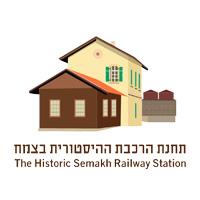A Strategic Historic Site
A strategic historic site
Visit the Semakh Railway Station
Alongside the academic activities, the restored railway station compound has become an active, vibrant tourism site, which includes a visitors’ center and museum that tell the story of the Valley Train and the Semakh Railway Station.
For details and booking: Tel. 04-6653786; 050-5656291
Email: zemachtrain@kinneret.ac.il
Internet: https://www.kinneret.ac.il
Semakh Railway Station / Tsemach
(87 kms from Haifa, inaugurated 15.10.1905)
The Semakh / Tzemach Railway station is the last station of the "Valley Railway". The station's unique location near the Sea of Galilee, in close proximity to the meeting of the three borders and on a major thoroughfare, had made it an important strategic landmark in the area, and regional battles have been fought around it. In the last weeks of WW1, a rare and daring night cavalry charge over unknown terrain by Australian Light Horsemen, defeated the German and Turkish forces, capturing the station and adjacent town. This was one of the last cavalry charges in modern times.
Later, in the early 1920s, fierce battles with Bedouin tribes took place at and around the station and in May 1948, Syrian armored forces overran the station, and attacking the Jordan Valley, before being stopped at the gates of Kibbutz Degania.
The train service from Semakh Railway station to Damascus and Amman ceased in 1946, after the destruction of the al-Hawa bridge over the Yarmouk on “the Night of the Bridges”. Semakh Railway station stopped operating altogether during the War of Independence.
The main Station building included a passenger hall, offices and the manager's famliy’s residence. Other buildings included a storage building, a water tower, a track workshop, a locomotive garage and a coal filling area. The station had a quarantine area for the livestock coming from Syria. The water tower’s oval shape was unique as it had two large tanks and was built of basalt stones. Pumps filled the tanks with water from the nearby sea of Galilee.
During the Turkish period, a turntable was installed at the station, which allowed the more powerful locomotives to return on the difficult ascent to Damascus along the Yarmouk Valley. A concrete tower was used to fill the locomotives with fuel oil, after the transition from coal. An underground fuel tank was built at the station in World War II, as a defense against attacks by the German airforce, which was feared might be assisted by the Vichy French regime in Syria.
The Historic Semakh Compound
The historic Semakh Railway Station was the final stop of the Valley Train during the Ottoman period. Its strategic location, on the shore of the Sea of Galilee and near the borders between Israel and its neighbors, has afforded it special status and facilities that did not exist in other stations. The station was built by Sultan Abdul Hamid the 2nd in an attempt to connect the Hamidiye Hijaz Railway with the Mediterranean coast. The section between Haifa and Semakh was eventually called the Valley Train.
Construction was completed in 1905, when the Semakh station was opened. The station generated regional development, and was an important center for the towns of Samakh (سمخ) and Tiberias, and for the Jordan Valley and Sea of Galilee surrounding settlements.
Our partners:














